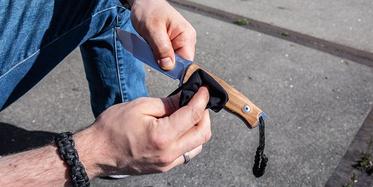How do you maintain a wooden handle?
Taking care of a knife with a wooden handle is not difficult at all. We will teach you how to take care of different wooden handles. This applies to outdoor knives with a wooden handle, but also for kitchen knives and other tools enhanced with a wooden handle.
Why is it important to maintain a wooden handle?
Wood can dry out. Whether you use it or not. Some types of wood are more susceptible to it than others, but in general a wooden handle feels a lot better after a couple drops of oil once in a while. It prevents cracks because it will become too dry and increases the resistance against changes in temperature and humidity. More importantly, a well-oiled handle looks a lot more beautiful because you can clearly see the wood pattern.
Which types of wood need to be enhanced with oil?
Basically any type of wooden handle could occasionally use a drop of oil. But there are exceptions: wooden handles already enhanced with polish or paint won’t absorb oil. In addition, stabilized types of wood, wood that has absorbed stabilization resin, won’t need as much oil as the non-stabilized types of wood.
It is important to know that there are many different ways and insights when it comes to maintaining wooden handles. While some think Danish oil is perfect, others prefer mineral oil. Some sand the oil down in the handle while others let the handle soak in a pot of oil. So, enough to think about.
How do you apply oil to the handle?
We prefer to apply the oil with a clean cloth. Not too much: a couple drops is often enough. Subsequently we allow the oil to be absorbed after which we rub the handle with another clean cloth. We repeat this process until the wood is saturated. You will quickly notice when it is because the wood won’t absorb any more oil.
Which oil do you use for wooden handles?
There are different types of oil that can be used to treat wooden handles. Each oil has its own properties and will respond differently to different types of wood. In addition, there are different types of oil that can be used for multiple purposes. As a result you can do different things with one bottle.
Ballistol
In our range Ballistol is one of the most popular types of oil. Originally developed as oil for weapons but today praised because of its versatility. It is an oil that revives dry wood. Ballistol can be used on all types of wood, with the exception of handles that have been painted. Ballistol, however, has a quite particular smell: like a pine forest in a jar. Some hate it, some love it and wish they could use it as eau de cologne.
Practical about Ballistol is that you can also rub it on your blade to prevent rust. In addition, Ballistol will help you remove any remaining tape from steel. Furthermore, Ballistol is used to keep leather flexible which makes it a great product to keep your sheath in great shape. Although Ballistol doesn’t mention it on the package we know that Ballistol is food safe. So you can even use it on your kitchen knives.
Eden Essentials mineral oil for wooden cutting boards
Eden Essentials cutting board oil is a thick paraffinic oil. It slightly seals the wood and takes care of a beautiful glossy finish. As the name might already suggest it is also great to treat wooden cutting boards.
Robert Herder maintenance oil for wooden handles
The Robert Herder maintenance oil for wooden handles is also a good option. The macadamia oil is great for the wood and the light fragrance of lemons definitely makes the knife smell amazing.
Danish oil
Amongst woodworkers the effect of Danish oil has been known for years. This mixture based on Tung oil deeply penetrates the wood. After applying and letting it dry it is key to rub the handle with a dry piece of cloth. That is how the natural pattern of the wood is best featured, but more importantly, you need to wipe of the excess Danish oil. If you allow the surface to dry a type of lacquer layer will form and that is something you want to avoid. The advantage of Danish oil is that after applying it the wood won’t dry out as quickly.
Linseed oil
Another remedy from a bygone age. It works the same as with Danish oil. Apply a thin coat, let it set and rub it afterwards to remove access oil. It is important to not let it dry on the blade! After all, it could get stuck on top like a type of lacquer, and that is not something you want.
Why not use olive oil?
Like with some cutting boards it is sometimes said that you can also take care of a wooden handle with olive oil. And in the short term that is true. The downside of olive oil, however, is that after a while it could get rancid. It will start to smell slightly stale and that is, of course, not preferred.










